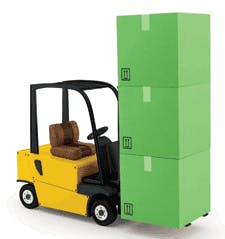If only environmental sustainability had a proven return on investment (ROI), it would be easy being green. Corporate executives would be singing that song all day. The problem is, executives haven't always connected the dots between the green of profit and the green of environmentalism. But according to research by PricewaterhouseCoopers, they do make the connection between the green of profit and the red of high and volatile energy costs. In fact those costs topped the list of concerns of both the industrial manufacturing executives and the transportation & logistics CEOs PwC surveyed recently.
Seventy percent of the manufacturing execs and 76% of the logistics execs said energy costs were among their key concerns—equating them with an increasing tax burden. There's good reason for concern. Demand for energy is forecast to increase by as much as 50% over the next 15 years. This may inspire the people taking these leaders' places within that time to finish connecting the dots leading from profit to energy to environmental sustainability.
PwC says today's CEOs will have to manage the transition to tomorrow's CEOs by becoming hybrid leaders who can run the business of today while creating the business of tomorrow.
That's why these CEOs are eyeing developments in alternative power sources.
Disconnect Between Infrastructure and Energy
While the transportation CEOs PwC studied put the state of roads and bridges high up on their worry list, infrastructure didn't place anywhere on that list for manufacturing CEOs. That may be because logistics executives tend to equate availability of energy with the means of delivering it. As the study's analysts state, "Trains, planes, ships and trucks all rely on fuel—so it's not surprising that transportation and logistics CEOs continue to worry more about high or volatile energy costs than do their colleagues across the overall sample. Since 2001 the price for crude oil has risen fourfold. Ongoing high oil prices will lead to an increased use of alternative fuels."
Andrew Winston says the philosophical transition from this generation of executives to the next will be more of a pivot—a "Big Pivot," which is the title of his new book. Winston, founder of Winston Eco-Strategies (www.andrewwinston.com), advises big corporations and sits on the sustainability advisory boards of Kimberly-Clark, Hewlett-Packard and Unilever. He also calls PwC one of his business partners. MH&L asked Winston if he was surprised that logistics executives found it easier to make the connection between energy costs and the state of our transportation infrastructure. He wasn't.
"We tend to look at what's directly relevant to our job," he answered. "The pivot is about realizing that resource constraints and input prices are rising, and that climate change and carbon are now everybody's job. If the infrastructure isn't there you won't get manufactured goods to market, no matter how lean you are about making them. You have to think about the cost of logistics and the cost of energy. That PwC finding shows there's a lack of that larger perspective."
Winston tells the story of one high-tech company where the environmental officer was arguing with the risk officer, telling him that he really needed to look at energy. The risk officer didn't see the connection to his job. But when the environmental officer made the connection between security and technology risks, the risk officer realized how dependent their business was on data centers and the cloud. Energy suddenly became one of this company's top three risks.
"We're very good at understanding the ‘I' side of ROI—what it will cost to make a change—but we're not so good at the ‘R,' figuring the return on the investment," Winston says. "Take investing in renewable energy for your distribution center so you can operate when the grid goes down, for example. Last year when Walmart made a huge commitment to renewable energy, one of their top executives said this commitment to having their own renewable energy allows them to stay up and running no matter who else is down. That's resilience and it's worth something."
How much? Ask the automotive industry. In 2011 after an earthquake and tsunami devastated parts of Japan, car makers in the U.S. discovered the pain of sourcing from a handful of Japanese suppliers of electronic components. This lesson helped them connect the dots between sustainability and power sources, shorter supply chains and efficient material handling.
The Supply Chain Factor
Tom Pettit, senior vice president and general manager of Ryder Supply Chain Solutions, says a total cost of ownership calculation must factor in labor and material costs, transportation costs, inventory carrying and quality costs.
"If you have a disruption and have 90 days of supply in the water between your factory dock and your warehouse, there's a pretty long chain of having to deal with that," he says. "That's why companies are thinking about reshoring—not just because of increases in wages and foreign exchange in Asia, but as they get more focused on lean and having shorter supply chains and greater flexibility, they want to be able to react faster to changes in demand. It's called having a best-cost country strategy. Companies that have been doing that have a shorter, more nimble supply chain."
Within the U.S., according to Pettit, manufacturers are going from distributing out of single, centralized warehouses to a more regional approach, with warehouses in the west, midwest and southeast. And with retailers fulfilling omni-channel orders out of their stores, they are covering 75% of the U.S. market within one day via ship- by-ground.
Even those companies that continue to source from overseas can make a sustainable difference once shipments arrive onshore. Pettit identifies postponement as a strategy that can make a significant dent in packaging waste.
"We put in automated sortation systems and packaging operations in some of our warehouses," he says. "In the past customers were packaging their end products overseas, in the case of toothbrushes or razors, one package for Walmart and four for Costco. They had to make all that in China and then send it over and hopefully they had the right assortments on the shelves. Now they're relying on packaging automation and the value added services in our DCs to do product postponement, where we import products in bulk and put them in different configurations—ones, twos and threes for Customer A or Customer B—and that way they cut down on obsolescence, waste and inventory costs."
The Greening of Intralogistics
Sustainability can even come down to your forklift fleet strategy, say the major OEMs in this space.
"We estimate energy costs to be about 5 percent of the total cost of operating a lift truck through its useful life," says Arlan Purdy, product manager with Raymond Corp. "A truck that's been designed for energy efficiency may save hundreds of dollars per year in electricity costs versus a heavier, less optimized truck. Sustainability really focuses on the big differences small changes can make. We estimate that for a fleet of 30 lift trucks working two shifts, 250 days per year, converting to reach trucks with regenerative braking and lowering is equivalent to taking ten cars off the road per year, in terms of CO2 emissions."
Mark Faiman, product manager for IC, GSC and AWP products at Toyota Material Handling, foresees a gradual shift in power sources for the heavy duty forklifts used in the yards of DCs as well.
"The trend will be the continued slow conversion to electric, especially where you've seen the introduction of the electric pneumatic trucks," he says. "There are a lot of incentives on the emissions side from power companies making a push in that direction. The big challenge is once you get above 12,000 pounds, due to the amount of battery you need. On the larger internal combustion trucks, everybody has been challenged with meeting Tier 4 final standards on the diesel products."
That's where propane may be an attractive alternative power source. Faiman notes that the airlines are considering propane for their ground support equipment.
"They decided they don't want to deal with the regulations and extra cost," he says. "You could start seeing large V8s with propane power in outdoor yard applications. With propane some fueling infrastructure has to be added for those types of applications, but the propane industry will probably come up with incentive programs for that."
Sustainability tends to stick when incentives are driven from inside a company. In his book, "The Big Pivot," Andrew Winston writes that major companies set aside funds for green investments. That's what many ch consumers do through layaway programs at Christmas time. For example, DuPont and building materials company Owens-Corning allocate a portion of their capital expenditures budget (from 1 to 10 percent) for energy efficiency initiatives. Johnson & Johnson created an internal carbon reduction fund, setting aside about $40 million a year. Managers apply for these funds to finance their sustainability projects.
"Mandating that some money goes to less exciting projects will unleash innovation and uncover ideas," Winston concludes. "And in this way the important (and profitable) does not always lose out to the urgent."
About the Author
Tom Andel
Editor-in-Chief
Tom Andel is an award-winning editorial content creator and manager with more than 35 years of industry experience. His writing spans several industrial disciplines, including power transmission, industrial controls, material handling & logistics, and supply chain management.



